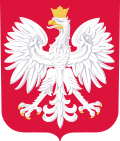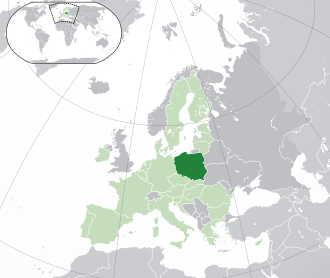Poland
country in Central Europe From Wikipedia, the free encyclopedia
Poland is a country in the eastern region of Central Europe.[18] Its official name is Republic of Poland. It is on the east of Germany (along Oder and Lusatian Neisse). The Czech Republic and Slovakia are to the south, Ukraine and Belarus to the east, and the Baltic Sea, Lithuania, and the Russian exclave of Kaliningrad to the north. The total land area of Poland is about 312,679 km2[19] (120,728 mi2), slightly larger than Oman. That makes Poland the 77th-largest country[19] in the world, with over 38.5 million people. Most Polish people live in large cities, including the capital, Warsaw (Polish: Warszawa), Łódź, Cracow (Polish: Kraków), the second capital of Poland (first was Gniezno), Szczecin, Gdańsk, Wrocław and Poznań.
Republic of Poland Rzeczpospolita Polska | |
|---|---|
| Anthem: "Mazurek Dąbrowskiego" ("Poland Is Not Yet Lost") | |
Location of Poland (dark green) – on the European continent (green & dark grey) | |
| Capital and largest city | Warsaw 52°13′N 21°02′E |
| Official language | Polish[1] |
| Ethnic groups (2021)[2] | |
| Religion (2021[3]) |
|
| Demonym(s) |
|
| Government | Unitary semi-presidential republic[8] |
| Andrzej Duda | |
| Donald Tusk | |
| Legislature | Parliament |
| Senate | |
| Sejm | |
| Formation | |
| c. 960 | |
| 14 April 966 | |
• Kingdom of Poland | 18 April 1025 |
| 1 July 1569 | |
| 11 November 1918 | |
| 17 September 1939 | |
| 22 July 1944 | |
• Third Republic | 31 December 1989[10] |
| Area | |
• Total | 312,696 km2 (120,733 sq mi)[11][12] (69th) |
• Water (%) | 1.48 (2015)[13] |
| Population | |
• 2022 census | 38,036,118[14] (38th) |
• Density | 122/km2 (316.0/sq mi) (75th) |
| GDP (PPP) | 2025 estimate |
• Total | $1.992 trillion[15] (19th) |
• Per capita | $54,498[15] (37th) |
| GDP (nominal) | 2025 estimate |
• Total | $915 billion[15] (21st) |
• Per capita | $25,041[15] (45th) |
| Gini (2022) | 26.3[16] low |
| HDI (2022) | 0.881[17] very high · 36th |
| Currency | Złoty (PLN) |
| Time zone | UTC+1 (CET) |
| UTC+2 (CEST) | |
| Date format | dd.mm.yyyy (CE) |
| Driving side | right |
| Calling code | +48 |
| ISO 3166 code | PL |
| Internet TLD | .pl |
| |
The word "Poland" was written officially for the first time in 966. In 1569, Poland formed a strong union with Lithuania called the Polish-Lithuanian Commonwealth. At some point in its history, it was the largest state in Europe and became very influential. Eventually, after a slow decline, the Commonwealth collapsed in 1795. Poland regained its independence in 1918, after World War I. In 1921, Poland defeated Soviet Russia in the Polish-Soviet War that started in 1919.
However, Poland lost independence again not long after the beginning of World War II, after suffering a defeat by both the Soviet Union and Nazi Germany. Although the government collapsed, the Polish people fought on by forming the largest and most effective resistance movement in German-occupied Europe. It is most notable for disrupting German supply lines to the Eastern Front of World War II, providing military intelligence to the British, and saving more Jewish lives in the Holocaust than any other Allied organization or government. After the war, Poland theoretically regained its independence but became a communist country within the Eastern Bloc. The new government was appointed by Joseph Stalin and was under the control of the Soviet Union.
In 1989, Poland ceased being a communist country and became a liberal democracy. Its change of government was the first in a series of events that led to the states of Eastern and Central Europe regaining their independence and the fall of the USSR in 1991. After the democratic consolidation, Poland joined the European Union on 1 May 2004. Poland is also a member of NATO, the United Nations, and the World Trade Organization.
History
Early history

The first sign of humans in Polish lands was 500,000 years ago. The Bronze Age started around 2400-2300 BC. The Iron Age started around 750-700 BC. At that time the Polish lands were under the influence of the Lusatian culture. About 400 BC Celtic and Germanic tribes lived there. Those people had trade contacts with the Roman Empire.
Over time, Slavs came to Polish lands. Some of those Slavs, now commonly referred to as Western Slavs (though in reality a diverse group of tribes with shared ethnic and cultural features), stayed there and started to create new nations. The most powerful tribe was called the Polans, who united all of the other Slavic tribes living there and is the origin of the name "Poland."
Piast and Jagiellon dynasties
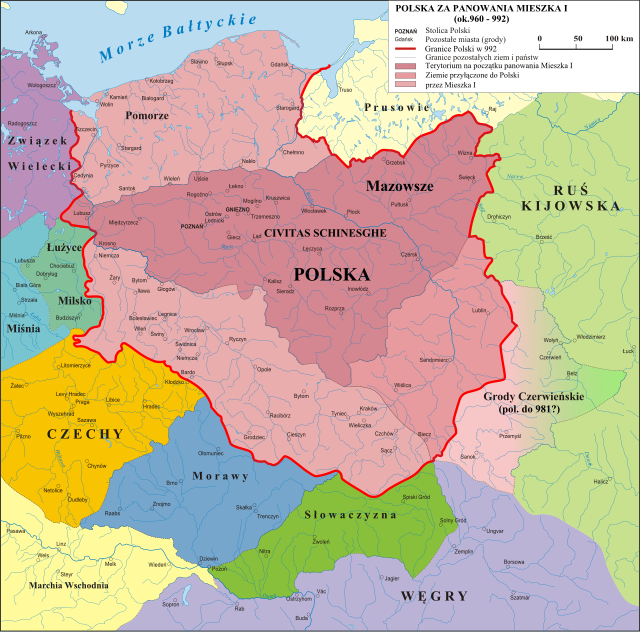

Poland began to form a country around the mid-10th century, during the Piast dynasty. In 966, Prince Mieszko I became a Christian and so the Polish people also became Christians. The next king was Bolesław I of Poland, nicknamed Bolesław the Brave. He conquered many lands and became the first King of Poland. Casimir I of Poland changed the Polish capital from Gniezno to Kraków. In the 12th century, Poland broke into some smaller states after the death of King Bolesław III Wrymouth in 1138 because of his will. Those states were later attacked by Mongol armies in 1241, which slowed down the unification of the small states into the large country of Poland. That finally happened eighty years later, in 1320 when Władysław I became the King of United Poland. His son Casimir III reformed the Polish economy, built new castles, and won the war against the Ruthenian Dukedom. Many people emigrated to Poland, which became a haven. Many Jewish people also moved into Poland during that time. The Black Death, which affected many parts of Europe from 1347 to 1351, did not come to Poland.[20]
After the death of Casimir the Great, the last Piast on the Polish throne, Louis I of Hungary and his daughter Jadwiga of Poland began their rule. She married the Lithuanian prince Jogaila. Their marriage started a new dynasty in Poland: the Jagiellon dynasty. Under the Jagiellon dynasty, Poland made an alliance with its neighbor Lithuania.
Polish-Lithuanian Commonwealth to Second Republic of Poland

In the 17th century Sweden attacked almost all of Poland (this was called “the Deluge”). Many wars against the Ottoman Empire, Russia, the Cossacks, Transylvania and Brandenburg-Prussia ended in 1699. For the next 80 years, the government and the nation were weak, which amde Poland dependent on Russia, whose tsars took advantage of this by offering money to dishonest members of the Polish government to block new ideas and solutions. Russia, Prussia, and Austria conquered all of Poland into three pieces in 1772, 1793 and 1795, which dissolved the country. A constitution called the Constitution of 3 May, was made in 1791.
Napoleon made another Polish state, the Duchy of Warsaw, but after the Napoleonic wars, Poland was divided again by the countries at the Congress of Vienna. The eastern part was ruled by the Russian tsar. The Polish people did not like that and often rebelled (two large rebellions in 1830[20] and 1863[21]). During World War I, the Allies agreed to restore the indoendence of Poland. Soon after the surrender of Germany in November 1918, Poland became the Second Polish Republic (II Rzeczpospolita Polska). It got its freedom after several military conflicts; the largest was the 1919-1921 Polish-Soviet War.
World War II

On September 1, 1939, World War II started when Germany attacked Poland. The Soviet Union attacked Poland on September 17. Warsaw was defeated on September 28. Poland divided into one part ruled by Nazi Germany and the other by the Soviet Union. More than 6 million Polish people died, and half of then were Jewish. Most of the deaths were part of the Holocaust in which 6 million Jews and 1.5 miilion Poles were killed. At the war's end, Poland's borders were moved west to push the eastern border to the Curzon line.[22] The western border was moved to the Oder-Neisse line. The new Poland became 20% smaller by 77,500 square kilometers (29,900 sq mi). The shift forced millions of Poles, Germans, Ukrainians, and Jews to move.
Polish People's Republic to Third Polish Republic
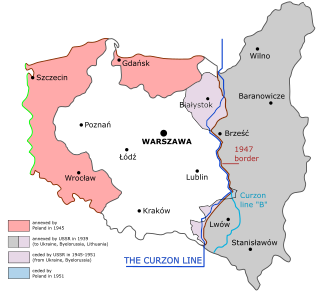
After these events, Poland gradually became a communist country. It was supposedly an independent country, but in reality, the new government was appointed by the Soviet leader, Joseph Stalin, and was under the control of the Soviet Union. The country was then renamed the People's Republic of Poland. There are many Poles in the neighboring countries Ukraine, Belarus, and Lithuania (the three countries were part of the Soviet Union until 1991), as well as in other countries. Most Poles outside of Poland are in the United States, especially in Chicago. Germany and the United Kingdom are also home to a large Polish diaspora. The most recent mass emigration of Poles to western countries began after 1989.
In 1989, Solidarity, a trade union led by Lech Wałęsa, helped to defeat the communist government in Poland. Even before that event, Lech Wałęsa was given a Nobel Prize for leading the first non-communist trade union fighting for democracy in the Eastern Bloc. When communism ended in Poland there were many improvements in human rights, such as freedom of speech, democracy, etc. In 1991 Poland became a member of the Visegrád Group and joined NATO in 1999 along with the Czech Republic and Hungary. Polish voters then voted to join the European Union in a vote in June 2003. The country joined the EU on May 1, 2004.
Currently, the Prime Minister is Mateusz Morawiecki. On 10 April 2010 the President Lech Kaczyński died in a government plane crash in Smolensk in Russia. The president is elected directly by the citizens for a five-year term. The Prime Minister is appointed by the President and confirmed by the Sejm, the lower chamber of Parliament legislature for the country. It has 460 deputies elected every four years.
Geography

Poland's territory is a plain reaching from the Baltic Sea in the north to the Carpathian Mountains in the south. Within that plain, the land varies from east to west.
The Polish Baltic coast is mostly smooth but has natural harbors in the Gdańsk-Gdynia region and Szczecin in the far northwest. This coast has several spits, dunes, and coastal lakes. Coast lakes are former bays that have been cut off from the sea. These areas are sometimes called lagoons. Szczecin Lagoon is on the western border with Germany. The Vistula Lagoon is on the eastern border with Kaliningrad, province of Russia. The longest river in Poland, the Vistula river, empties into the Vistula Lagoon and also directly into the Baltic Sea.
The northeastern region is densely wooded, sparsely populated, and lacks agricultural and industrial resources. The geographical region has four hilly districts of moraines and lakes created by moraines. These formed during and after the Pleistocene ice age. The Masurian Lake District is the largest of the four districts and covers much of northeastern Poland.
Poland has many lakes. In Europe, only Finland has more lakes. The largest lakes are Śniardwy and Mamry. In addition to the lake districts in the north, there are also many mountain lakes in the Tatras mountains.
South of the northeastern region is the regions of Silesia and Masovia, which are marked by the broad ice-age river valleys. The Silesia region has many resources and people. Coal is abundant. Lower Silesia has large copper mining. Masovian Plain is in central Poland. It is in the valleys of three large rivers: Vistula, Bug and Narew.
Further south is the Polish mountain region. These mountains include the Sudetes and the Carpathian Mountains. The highest part of the Carpathians is the Tatra mountains which is along Poland’s southern border. The tallest mountain in Poland, Rysy at 2,503 m (8,210 ft), is in the High Tatras.
Climate
Poland has a continental climate.
The highest temperature ever recorded in Poland was 40.2 °C (104.4 °F) on 29 July 1921 in Prószków. The lowest temperature ever recorded in Poland was −41.0 °C (−41.8 °F) on 11 January 1940 in Siedlce.
Top 5 warmest days
| Rank | Temperature | Date | Location |
|---|---|---|---|
| 1. | 40.2 °C (104.4 °F) | 29 July 1921 | Prószków |
| 2. | 38.4 °C (101.1 °F) | 19 June 2022 | Słubice |
| 3. | 38.2 °C (100.8 °F) | 26 July 2019 | Radzyń |
| 4. | 37.6 °C (99.7 °F) | 20 July 2022 | Wrocław |
| 5. | 37.3 °C (99.1 °F) | 1 August 2020, 13 July 2010 | Kikoły, Hajnowka |
Administrative divisions
Poland is made of sixteen regions known as voivodeships (województwa, singular - województwo). They are basically created from the country's historical regions, whereas those of the past two decades (till 1998) had been focused on and named for separate cities. The new units range in areas from under 10,000 km2 (Opole Voivodeship) to over 35,000 km2 (Masovian Voivodeship). Voivodeships are controlled by voivod governments, and their legislatures are called voivodeship sejmiks.
The sixteen voivodeships that make up Poland are further divided into powiaty (singular powiat), second-level units of administration, which are about the same as to a county, district or prefecture in other countries.
|
||||||||||||||||||||||||||||||||||||||||||||||||||||||||
Literature

Almost no Polish literature remains before Christianisation in the 10th century. Polish literature was written in the Latin language during the Middle Ages. The Polish language was accepted as equal to Latin after the Renaissance for literature.
Jan Kochanowski was a leading poet of European Renaissance literature in the 16th century. Other great Polish poets include Adam Mickiewicz who wrote Pan Tadeusz epic in 1834.
Several Polish novelists have won the Nobel prize. Henryk Sienkiewicz won in 1905 dramatized versions of beginnings of Christianity (Quo Vadis). Władysław Reymont won a Nobel prize in 1924. He wrote the novel Chłopi, recently filmed. Olga Tokarczuk 2018. Two Polish poets won Nobel prizes as well. One is Czesław Miłosz (1980) and the second Wisława Szymborska (1996).
Stanisław Lem is a famous science fiction author in the modern era. His Solaris novel was made twice into a feature film.
People

In the past, Poland was inhabited by people from different nations and of different religions (mainly Catholics, Orthodox and Judaism). This changed after 1939, because of the Nazi Holocaust which killed many Polish Jews. After World War II, the country was changed into a communist country, by the Warsaw Pact which included most central European countries and Russia Russia.
Today 38,038,000 people live in Poland (2011). In 2002 96.74% of the population call themselves Polish, while 471,500 people (1.23%) claimed another nationality. 774,900 people (2.03%) did not declare any nationality. Nationalities, or ethnic groups in Poland are Silesians, Germans (most in the former Opole Voivodeship), Ukrainians, Lithuanians, Russians, Jews, Roma and Belarusians. The Polish language is part of the West Slavic section of the Slavic languages. It is also the official language of Poland. English and German are the most common second languages studied and spoken.

In the past few years, Poland's population has gone down because of an increase in emigration and a sharp drop in the birth rate. In 2006, the census office estimated the total population of Poland at 38,536,869, a very small rise from the 2002 figure of 38,230,080. Since Poland's accession to the European Union, many Polish people have moved to work in Western European countries like the United Kingdom and the Republic of Ireland. Some organizations state people have left because of high unemployment (10.5%) and better opportunities for work somewhere else. In April 2007, the Polish population of the United Kingdom had risen to about 300,000 people and estimates predict about 65,000 Polish people living in the Republic of Ireland. However, in recent years strong growth of the Polish economy and the increasing value of Polish currency (PLN) makes many Polish immigrants go back home. In 2007, the number of people leaving the country was lower than people who are coming back. Poland became an attractive place to work for people from other countries (mainly Ukraine).
A Polish minority is still present in neighboring countries of Ukraine, Belarus, and Lithuania, as well as in other countries. The largest number of ethnic Poles outside of the country can be found in the United States.
Famous people
- Fryderyk Chopin, a music composer.
- Joseph Conrad, born Józef Teodor Konrad Korzeniowski, an acclaimed author who however wrote in English.
- Nicolaus Copernicus, an astronomer who showed that the Earth moves around the Sun.
- Maria Skłodowska-Curie discovered radium and polonium.
- Franciszek Kamieński, discovered mycorrhiza.
- Tadeusz Kościuszko, an army commander who fought for USA's and Poland's independence.
- Robert Kubica, a F1 driver.
- Stanisław Lem, a science fiction writer.
- Adam Małysz, a ski-jumper.
- Adam Mickiewicz, a poet
- Pope John Paul II (earlier Karol Wojtyła). Before he became Pope, he was a Bishop in Kraków.
- Agnieszka Radwańska, female tennis player
- Władysław Reymont, a novelist
- Henryk Sienkiewicz, a novelist
- Kamil Stoch, a ski jumper
- Wisława Szymborska, a writer
- Andrzej Wajda, a film director
- Lech Wałęsa, leader of "Solidarność" ("Solidarity"), he helped defeat the communist government in Poland and USSR influence in Central and Eastern Europe
- Robert Lewandowski, a football player
- Czesław Miłosz, a poet
- Jan Matejko, a painter
Urban demographics
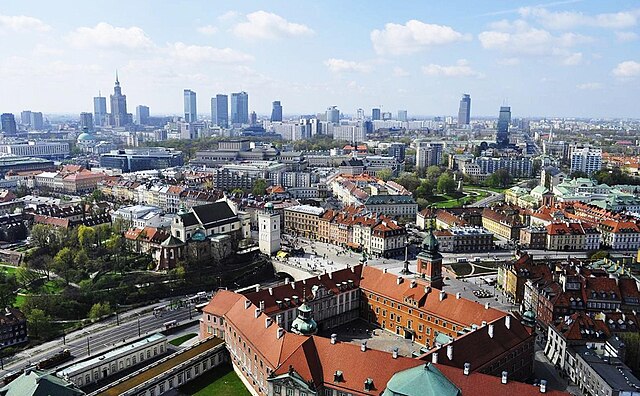







The lists below show the population count of Poland's largest cities based on 2005 estimates.
| Agglomeration or conurbation | Voivodeship | Inhabitants (Estimated, 2005) | |
|---|---|---|---|
| 1 | Katowice (USIA) | Silesia | 3,487,000 |
| 2 | Warsaw (Warszawa) | Masovia | 2,679,000 |
| 3 | Kraków | Lesser Poland | 1,400,000 |
| 4 | Łódź | Łódź | 1,300,000 |
| 5 | Tricity | Pomerania | 1,100,000 |
| 6 | Poznań | Greater Poland | 1,000,000 |
| City | Voivodeship | Inhabitants May 20, 2002 |
Inhabitants December 31, 2004 | |
|---|---|---|---|---|
| 1 | Warsaw (Warszawa) | Masovia | 1,671,670 | 1,692,854 |
| 2 | Łódź | Łódź | 789,318 | 774,004 |
| 3 | Kraków | Lesser Poland | 758,544 | 757,430 |
| 4 | Wrocław | Lower Silesia | 640,367 | 636,268 |
| 5 | Poznań | Greater Poland | 578,886 | 570,778 |
| 6 | Gdańsk | Pomerania | 461,334 | 459,072 |
| 7 | Szczecin | Western Pomerania | 415,399 | 411,900 |
| 8 | Bydgoszcz | Kuyavia-Pomerania | 373,804 | 368,235 |
| 9 | Lublin | Lublin | 357,110 | 355,998 |
| 10 | Katowice | Silesia | 327,222 | 319,904 |
| 11 | Białystok | Podlaskie | 291,383 | 292,150 |
| 12 | Gdynia | Pomerania | 253,458 | 253,324 |
| 13 | Częstochowa | Silesia | 251,436 | 248,032 |
| 14 | Sosnowiec | Silesia | 232,622 | 228,192 |
| 15 | Radom | Masovia | 229,699 | 227,613 |
| 16 | Kielce | Świętokrzyskie | 212,429 | 209,455 |
| 17 | Toruń | Kuyavia-Pomerania | 211,243 | 208,278 |
| 18 | Gliwice | Silesia | 203,814 | 200,361 |
| 19 | Zabrze | Silesia | 195,293 | 192,546 |
| 20 | Bytom | Silesia | 193,546 | 189,535 |
| 21 | Bielsko-Biała | Silesia | 178,028 | 176,987 |
| 22 | Olsztyn | Warmia-Masuria | 173,102 | 174,550 |
| 23 | Rzeszów | Subcarpathia | 160,376 | 159,020 |
| 24 | Ruda Śląska | Silesia | 150,595 | 147,403 |
| 25 | Rybnik | Silesia | 142,731 | 141,755 |
| 26 | Tychy | Silesia | 132,816 | 131,547 |
| 27 | Dąbrowa Górnicza | Silesia | 132,236 | 130,789 |
| 28 | Opole | Opole | 129,946 | 128,864 |
| 29 | Płock | Masovia | 128,361 | 127,841 |
| 30 | Elbląg | Warmia-Masuria | 128,134 | 127,655 |
| 31 | Wałbrzych | Lower Silesia | 130,268 | 127,566 |
| 32 | Gorzów Wielkopolski | Lubusz | 125,914 | 125,578 |
| 33 | Włocławek | Kuyavia-Pomerania | 121,229 | 120,369 |
| 34 | Tarnów | Lesser Poland | 119,913 | 118,267 |
| 35 | Zielona Góra | Lubusz | 118,293 | 118,516 |
| 36 | Chorzów | Silesia | 117,430 | 115,241 |
| 37 | Kalisz | Greater Poland | 109,498 | 108,792 |
| 38 | Koszalin | Western Pomerania | 108,709 | 107,773 |
| 39 | Legnica | Lower Silesia | 107,100 | 106,143 |
| 40 | Słupsk | Pomerania | 100,376 | 99,827 |
| 41 | Grudziądz | Kuyavia-Pomerania | 99,943 | 98,757 |
| 42 | Jaworzno | Silesia | 98,780 | 96,600 |
Related pages
Notes
- "The dukes (dux) were originally the commanders of an armed retinue (drużyna) with which they broke the authority of the chieftains of the clans, thus transforming the original tribal organisation into a territorial unit."[9]
- "Mieszko accepted Roman Catholicism via Bohemia in 966. A missionary bishopric directly dependent on the papacy was established in Poznań. This was the true beginning of Polish history, for Christianity was a carrier of Western civilisation with which Poland was henceforth associated."[9]
References
Other websites
Wikiwand - on
Seamless Wikipedia browsing. On steroids.


